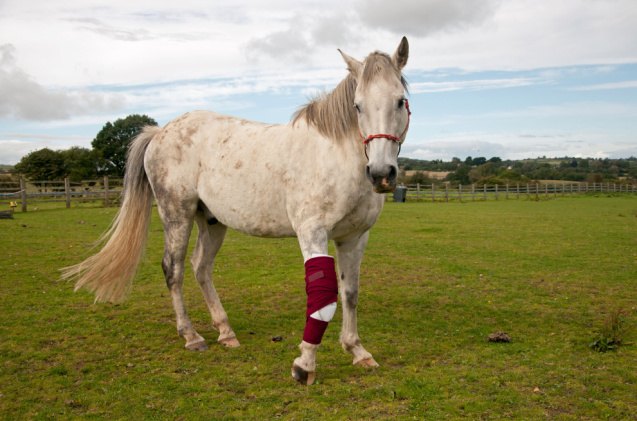5 Most Common Horse Injuries and How to Treat Them

In the lifetime of every horse, injuries are bound to happen at some time – maybe even more than once. This is especially true for horses that are fairly active, such as race and show horses, or work horses. These injuries can be fairly common and range from minor ones to major ones. Either way, as a responsible horse owner, you should be familiar with the most common of these injuries and just how to treat them before the vet arrives (if needed).
#1 Punctures
Scrapes, cuts, punctures – these are some of the most common injuries to happen to horses. They are usually caused by long and sharp objects that can penetrate deep below the skin. For example, imagine a long thorn piercing the horse's leg as they trundle through a bush, or a sharp piece of wire hiding in the dust poking deep into the hoof. These injuries are hard to avoid, especially since you simply can’t know what hides in the dirt or the grass. But you can treat them. And time is of the essence in such a case, as untreated puncture wounds can get infected, damaging the horse's leg and causing lameness. Keep in mind that punctures are not the same as slashes. They can be easy to overlook since the puncture is marked only by a tiny wound. However, it is hard to properly handle such a wound, unless you are a pro. You should call the vet immediately, and try to relieve the pain of the wound by hosing it with cold water.
#2 Inflamed Joints (Osteoarthritis)
Joint inflammation can affect both senior and younger horses, and usually targets parts called the “coffin”, hock joints, and fetlock. A common way for inflammation to occur is through a sudden increase in workloads, as well as certain movements that a horse might perform, such as jumping, tight turns, collected gaits, novel footing, or any other uncommon movements. Working on difficult rocky terrain for prolonged periods can also cause such inflammation. Joint inflammation can appear suddenly and unexpectedly, and disappear quite quickly. But if it keeps reappearing, it can turn into osteoarthritis, which can be more difficult to cure. Sings of joint inflammation are subtle, but still noticeable: difficulty moving, stiff and unusual movements, and later swelling, heat, and pain. This condition unarguably requires a careful veterinary examination, and a lighter case of inflammation can be relieved with box rest and cold hosing of the inflamed joints.
#3 Soreness
Sore muscles affect all creatures. But horses, being so powerfully built, can feel that ailment more than others. It is true that hard work and exercise will build muscle, but when you overwork your horse, soreness can occur. Strained muscles are painful and can quickly lead to more serious injury. They are commonly seen in horses, and usually target a single group of muscles that is continually overworked. For example, it is common in dressage horses, who place greater focus on their hind quarters. Muscle soreness is a common injury, but is considered mild, and its symptoms can be somewhat difficult to spot. Keep an eye out for stiff movements or avoidance of certain exercises. To treat this injury, give your horse some time off to rest and relax, and try massaging the affected muscles. Also, don’t rush into their exercises – give them time to warm up.
#4 Strained ligaments
Ligaments are very important in a horse’s body, and certain accidents can cause them to be strained, especially in the hind legs. These injuries are caused by missteps, increased stress, or a particularly hard landing. As such, the injury is common in show horses that perform jumps or in dressage horses. Furthermore, a ligament injury can range from light to heavy – or in other words, from strain to a tear. This is a potentially serious injury, and recovery of a ligament can take months and up to a year. Of course, veterinary care is necessary, and plenty of rest throughout. And even when the ligament is healed, your horse will have to get back into action gradually and with plenty of patience and care. To prevent this injury from occurring, avoid overworking your horse or exercising on uneven and unpredictable ground.
#5 Abrasions
Just like punctures, abrasions are perhaps the most common horse injury of all. They usually occur on the legs, especially the lower part, and can happen during work or exercise. Abrasions are varied and can range from scrapes to large open cuts and slashes. A common way they can occur is through low foliage, thorn bushes, barbed wire fences, sharp rocks, and anything in between. They can also be lighter or more serious, and depending on this, you can potentially treat them yourself, or call in a veterinarian. Either way, these abrasions will need to be cleaned and sanitized, because if left untreated, they can get infected and cause further trouble!

A proud mama to seven dogs and ten cats, Angela spends her days writing for her fellow pet parents and pampering her furballs, all of whom are rescues. When she's not gushing over her adorable cats or playing with her dogs, she can be found curled up with a good fantasy book.
More by Angela Vuckovic























